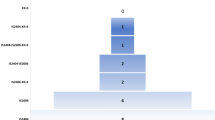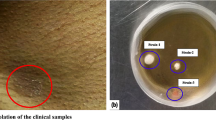Abstract
Foot hyperkeratosis is common. They often coincide with fungal infections, are difficult to cure and relapse rates are high. In this case study, longstanding and intractable plantar hyperkeratotic lesions were investigated for potential causative agents by histological examinations, by using human cell culture medium to grow the infected skin tissue, by sequencing ribosomal DNA and whole genome. Aspergillus sydowii was identified as the pathogen in the hyperkeratotic lesions. A peculiars intracellular infection of the fungus appeared to merge with anucleated epithelial cells of the skin, in which not fungal cells but basophilic nucleus-like bodies and abundant fungal proteins were seen in the cells. The composite fungal–human zombie-like cells were found to grow in the culture and in hyperkeratotic lesions, and some were readily transformed to natural fungus. Such zombie cells might play roles in the pathogenesis and recurrences of plantar hyperkeratotic lesions, resistance to antifungal drugs and relapses of the fungal infections.




Similar content being viewed by others
References
Spink MJ, Menz HB, Lord SR. Distribution and correlates of plantar hyperkeratotic lesions in older people. J Foot Ankle Res. 2009;2:8.
Dunn JE, Link CL, Felson DT, Crincoli MG, Keysor JJ, McKinlay JB. Prevalence of foot and ankle conditions in a multiethnic community sample of older adults. Am J Epidemiol. 2004;159(5):491–8.
Freeman DB. Corns and calluses resulting from mechanical hyperkeratosis. Am Fam Physician. 2002;65(11):2277–80.
Burzykowski T, Molenberghs G, Abeck D, et al. High prevalence of foot diseases in Europe: results of the Achilles Project. Mycoses. 2003;46(11–12):496–505.
Westerberg DP, Voyack MJ. Onychomycosis: current trends in diagnosis and treatment. Am Fam Physician. 2013;88(11):762–70.
Gibbons JG, Rokas A. The function and evolution of the Aspergillus genome. Trends Microbiol. 2013;21(1):14–22.
Paulussen C, Hallsworth JE, Álvarez-Pérez S, et al. Ecology of aspergillosis: insights into the pathogenic potency of Aspergillus fumigatus and some other Aspergillus species. Microb Biotechnol. 2016;10(2):296–322.
Bongomin F, Batac CR, Richardson MD, Denning DW. A review of onychomycosis due to Aspergillus species. Mycopathologia. 2018;183(3):485–93.
Wijesuriya TM, Kottahachchi J, Gunasekara TD, et al. Aspergillus species: an emerging pathogen in onychomycosis among diabetics. Indian J Endocrinol Metab. 2015;19(6):811–6.
Casadevall A. Evolution of intracellular pathogens. Annu Rev Microbiol. 2008;62:19–33.
Strober W. Trypan blue exclusion test of cell viability. Curr Protoc Immunol. 2015;111:A3.B.1-3.
Boedijn KB. Trypan blue as stain for fungi. Stain Technol. 1956;31(3):115–6.
White TJ, Bruns T, Lee S, Taylor JW. Amplification and direct sequencing of fungal ribosomal RNA genes for phylogenetics. In: Innis MA, Gelfand DH, Sninsky JJ, White TJ, editors. PCR protocols: a guide to methods and applications. New York: Academic Press Inc; 1990. p. 315–22.
Altschul SF, Gish W, Miller W, Myers EW, Lipman DJ. Basic local alignment search tool. J Mol Biol. 1990;215:403–10.
Index of download sequence of A. sydowii. http://www.Aspergillusgenome.org/download/sequence/A_sydowii/. Accessed 18 Jan 2017.
Westerberg DP, Voyack MJ. Onychomycosis: current trends in diagnosis and treatment. Am Fam Physician. 2013;88(11):762–70.
Dohmen PM, Weymann A, Holinski S, et al. Use of an antimicrobial skin sealant reduces surgical site infection in patients undergoing routine cardiac surgery. Surg Infect (Larchmt). 2011;12(6):475–81.
de Vries RP, Riley R, Wiebenga A, et al. Comparative genomics reveals high biological diversity and specific adaptations in the industrially and medically important fungal genus Aspergillus. Genome Biol. 2017;18(1):28.
Jorgensen P, Edgington NP, Schneider BL, Rupes I, Tyers M, Futcher B. The size of the nucleus increases as yeast cells grow. Mol Biol Cell. 2007;18(9):3523–32.
Bliska JB, Casadevall A. Intracellular pathogenic bacteria and fungi—a case of convergent evolution? Nat Rev Microbiol. 2009;7(2):165–71.
Nordberg H, Cantor M, Dusheyko S, et al. The genome portal of the Department of Energy Joint Genome Institute: 2014 updates. Nucleic Acids Res. 2014;42(1):D26–31.
Grigoriev IV, Nordberg H, Shabalov I, et al. The genome portal of the Department of Energy Joint Genome Institute. Nucleic Acids Res. 2012;40:D26–32.
Roemer T, Krysan DJ. Antifungal drug development: challenges, unmet clinical needs, and new approaches. Cold Spring Harb Perspect Med. 2014;4(5):a019703.
Krappmann S. How to invade a susceptible host: cellular aspects of aspergillosis. Curr Opin Microbiol. 2016;34:136–46.
Stappers MHT, Clark AE, Aimanianda V, et al. Recognition of DHN-melanin by a C-type lectin receptor is required for immunity to Aspergillus. Nature. 2018;555(7696):382–6.
Gniadek A. Cytotoxicity of Aspergillus fungi as a potential infectious threat. In: Priti R, editors. Insight and control of infectious disease in global scenario; 2012. p. 231–48.
Zhu CX. Season, weather, arthritis, dermatitis and cardiovascular abnormalities—a case of systemic diseases caused by fungal foot infection and its secreted proteins. 2018. https://doi.org/10.13140/rg.2.2.11508.60807. https://www.researchgate.net/publication/329906487. Accessed 18 Jan 2019.
Acknowledgements
At the completion of writing this research paper, the author feels deeply indebted to many people who have helped him in the entire process of this work and wish to thank them all. Ningning Ma, Ph.D. Yishengke Co. Ltd., Shenzhen, China. Dr. Ma provided the kind gift of ATG293 medium. Xiang Mack, MD. Kaiser Permanente Care Delivery Technology Services, San Francisco, California, USA, Dr. Mark provided medical terminology discussions and consulting. Karl Mack, Ph.D., San Francisco, California, USA. Dr. Mack helped proofreading and providing critique and suggestions on an early draft of manuscript. BioLake, Wuhan (The Wuhan National Biomedical Research and Business Park), provided rental spaces and services for setting up the research lab and conducting this work.
Funding
This research project was solely the authors’ devotions of individual efforts and resources to understanding the mechanisms of diseases and to contributing the improvements of public health and the advances of biomedical sciences, no public or private funding was received for this research.
Author information
Authors and Affiliations
Contributions
Author Contributions
CXZ conceived and designed the study and guided the interpretation of the results. CZX, XHL, XGT, and DGW conducted experiments and data analysis. CXZ provided the human subject data and analysis. CXZ drafted the manuscript. All authors discussed the results, edited and approved the draft and final versions of the manuscript.
Corresponding author
Ethics declarations
Conflict of interest
The authors certify that they have NO affiliations with or involvement in any organization or entity with any financial interest (such as honoraria; educational grants; participation in speakers’ bureaus; membership, employment, consultancies, stock ownership, or other equity interest; and expert testimony or patent-licensing arrangements), or non-financial interest (such as personal or professional relationships, affiliations, knowledge or beliefs) in the subject matter or materials discussed in this manuscript.
Ethical Approval
This research can be categorized as a self-experimentation of individual’s constitutional rights, no ethical approval is required.
Human and Animal Rights
The human subject, author CZ, for the purpose of this study was to examine the effect only on the researcher, and International Committee of Medical Journal Editors (ICMJE) registration is not required.
Additional information
Publisher's Note
Springer Nature remains neutral with regard to jurisdictional claims in published maps and institutional affiliations.
Handling Editor: Jean-Pierre Gangneux.
Rights and permissions
About this article
Cite this article
Zhu, C.X., Li, X., Tan, X. et al. Zombie Cells, Composite Cells of Fungal–Human Keratinocytes of Plantar Hyperkeratosis-Like Lesions. Mycopathologia 184, 597–605 (2019). https://doi.org/10.1007/s11046-019-00369-0
Received:
Accepted:
Published:
Issue Date:
DOI: https://doi.org/10.1007/s11046-019-00369-0




